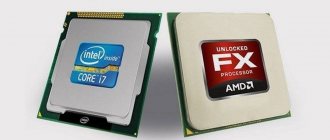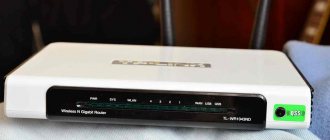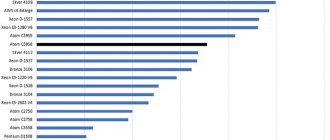The first ARM chips appeared three decades ago thanks to the efforts of the British company Acorn Computers (now ARM Limited), but for a long time they remained in the shadow of their more famous brothers - x86 processors. Everything turned upside down with the transition of the IT industry to the post-computer era, when mobile gadgets, rather than PCs, began to rule the roost.
Features of the ARM architecture
Perhaps it’s worth starting with the fact that the x86 processor architecture, which is currently used by Intel and AMD, uses the CISC (Complex Instruction Set Computer) instruction set, although not in its pure form. Thus, a large number of complex commands, which has long been a hallmark of CISC, are first decoded into simple ones, and only then processed. It’s clear that this entire chain of actions takes a lot of energy.
The ARM1 chip is the first-born of Acorn Computers, which was produced at VLSI factories
An energy-efficient alternative is ARM architecture chips with the RISC (Reduced Instruction Set Computer) instruction set. Its advantage is an initially small set of simple commands that are processed with minimal effort. As a result, two processor architectures – x86 and ARM – coexist peacefully (actually, not very peacefully) in the consumer electronics market, each of which has its own advantages and disadvantages.
The first ever device based on an ARM processor was the BBC Micro personal computer.
The x86 architecture is positioned as more universal in terms of the tasks it can handle, including even resource-intensive ones such as photo, music and video editing, as well as data encryption and compression. In turn, the ARM architecture excels due to its extremely low power consumption and generally sufficient performance for the most important purposes today: rendering web pages and playing media content.
Architectural differences between x86 (CISC instruction set) and ARM (RISC instruction set) processors
conclusions
In this article we looked at how ARM differs from x86. The differences are quite serious. But lately the line between both architectures has become blurred. ARM processors are becoming more productive and faster, and x86 processors, thanks to the reduction in the size of the board's structural element, begin to consume less power and generate less heat. You can already find ARM processors on servers and laptops, and x86 on tablets and smartphones.
What do you think about these x86 and ARM? What technology is the future in your opinion? Write in the comments! By the way, Linus Torvalds prefers x86.
To conclude the video about the development of the ARM architecture:
Related posts:
No similar posts
Business model of ARM Limited
Currently, ARM Limited is only engaged in the development of reference processor architectures and their licensing. The creation of specific chip models and their subsequent mass production is the job of ARM licensees, of which there are a great many. Among them there are companies known only in narrow circles like STMicroelectronics, HiSilicon and Atmel, as well as IT giants whose names are well-known - Samsung, NVIDIA and Qualcomm. The full list of licensee companies can be found on the corresponding page of the official website of ARM Limited.
There are several dozen companies alone that have received a license to produce ARM Cortex-A family chips, but ARM Limited has other developments in its portfolio
Such a large number of licensees is primarily due to the abundance of applications for ARM processors, and mobile gadgets are just the tip of the iceberg. Inexpensive and energy-efficient chips are used in embedded systems, networking equipment and instrumentation. Payment terminals, external 3G modems and sports heart rate monitors - all these devices are based on ARM processor architecture.
The Russian company, headquartered in Zelenograd, interestingly, also received a license to produce ARM architecture chips
According to analysts, ARM Limited itself earns $0.067 in royalties on each chip produced. But this is a very average amount, because the cost of the latest multi-core processors is significantly higher than single-core chips of outdated architecture.
Until recently, ARM, the developer of the processor architectures of the same name, paid close attention to code portability. Code once created for a specific version of the kernel should work everywhere, regardless of which company implemented this kernel in silicon.
Moreover, ARM last year, on a specially created website that was hastily deleted, explicitly stated that the competing, open RISC-V architecture was at risk of fragmentation due to the ability to add its own instructions. However, now the company itself has backed down.
At the ARM Techcon 2020 event, the company announced the ability to add custom instructions for processors with the ARMv8-M architecture. Cortex-M33 cores for microcontrollers will be the first to receive it. The licensing cost will not change. The Cortex-M33 design will thus be optimized to speed up today's popular machine learning and artificial intelligence tasks.
Architectural support for custom instructions is achieved by adding a special custom module to the Cortex-M33 core, which shares access interfaces with a regular ALU. Up to 8 regions are available for modification, depending on the type and number of specific instructions that are planned to be added.
As a measure to protect against excessive fragmentation, a special NOCP exception will be added, which will be thrown by the kernel when attempting to run unsupported code. In addition, the presence of a basic set of instructions is still required.
The implementation of support for custom instruction sets is planned to begin in the first half of 2020. New ARM processors with custom instructions should be expected in 2020 or 2021. Companies such as STMicro, NXP and Silicon Labs have shown interest. Detailed information about support for custom instructions can be found on the ARM Developer website.
If you notice an error, select it with the mouse and press CTRL+ENTER. | Can you write better? We always welcome new authors.
Single-chip system
From a technical point of view, calling ARM architecture chips processors is not entirely correct, because in addition to one or more computing cores, they include a number of related components. More appropriate in this case are the terms single-chip system and system-on-a-chip (from the English system on a chip).
Thus, the latest single-chip systems for smartphones and tablet computers include a RAM controller, graphics accelerator, video decoder, audio codec and optional wireless communication modules. Highly specialized chips may include additional controllers to interface with peripheral devices such as sensors.
Scheme of the structure of a single-chip system with four ARM Cortex-A9 cores
Individual components of a single-chip system can be developed either directly by ARM Limited or by third-party companies. A striking example of this are graphics accelerators, which in addition to ARM Limited (Mali graphics) are being developed by Qualcomm (Adreno graphics) and NVIDIA (GeForce ULP graphics).
We should not forget about the company Imagination Technologies, which does not do anything other than design PowerVR graphics accelerators. But it owns almost half of the global mobile graphics market: Apple and Amazon gadgets, Samsung Galaxy Tab 2 tablets, as well as inexpensive smartphones based on MTK processors.
Outdated generations of chips
Morally outdated, but still widely used processor architectures are ARM9 and ARM11, which belong to the ARMv5 and ARMv6 families, respectively.
ARM9 . ARM9 chips can reach clock speeds of 400 MHz and are most likely what is found inside your wireless router and older but still reliable mobile phones like the Sony Ericsson K750i and Nokia 6300. Critical to ARM9 chips is the Jazelle instruction set, which allows comfortable working with Java applications (Opera Mini, Jimm, Foliant, etc.).
ARM11 . ARM11 processors boast an expanded set of instructions compared to ARM9 and a much higher clock frequency (up to 1 GHz), although their power is also not enough for modern tasks. However, due to low power consumption and, no less important, cost, ARM11 chips are still used in entry-level smartphones: Samsung Galaxy Pocket and Nokia 500.
The Broadcom Thunderbird chip is one of the few representatives of the ARM11 generation that is still used in Android smartphones
Modern generations of chips
All more or less new ARM architecture chips belong to the ARMv7 family, the flagship representatives of which have already reached eight cores and a clock speed of over 2 GHz. The processor cores developed directly by ARM Limited belong to the Cortex line and most manufacturers of single-chip systems use them without significant changes. Only Qualcomm and Apple have created their own modifications based on ARMv7 - the first called their creations Scorpion and Krait, and the second - Swift.
The Apple A6 chip (Swift core) is Cupertino's first attempt to independently modify the ARMv7 architecture
ARM Cortex-A8. Historically, the first processor core of the ARMv7 family was the Cortex-A8, which formed the basis for such famous SoCs of its time as the Apple A4 (iPhone 4 and iPad) and Samsung Hummingbird (Samsung Galaxy S and Galaxy Tab). It demonstrates approximately twice the performance compared to the predecessor ARM11. In addition, the Cortex-A8 core received a NEON coprocessor for processing high-resolution video and support for the Adobe Flash plug-in.
True, all this negatively affected the power consumption of Cortex-A8, which is significantly higher than that of ARM11. Despite the fact that ARM Cortex-A8 chips are still used in budget tablets (Allwiner Boxchip A10 single-chip system), their days on the market are apparently numbered.
The TI OMAP 3 single-chip system is a representative of the once popular, but now fading generation of ARM Cortex-A8
ARM Cortex-A9. Following Cortex-A8, ARM Limited introduced a new generation of chips - Cortex-A9, which is now the most common and occupies an average price niche. The performance of Cortex-A9 cores has increased approximately threefold compared to Cortex-A8, and it is also possible to combine two or even four of them on one chip.
The NEON coprocessor has become optional: NVIDIA abolished it in its Tegra 2 single-chip system, deciding to free up more space for the graphics accelerator. True, nothing good came of this, because most video player applications still relied on the time-tested NEON.
Almost all flagship tablet computers of 2011 were built on the NVIDIA Tegra 2 chip
It was during the “reign” of Cortex-A9 that the first implementations of the big.LITTLE concept proposed by ARM Limited appeared, according to which single-chip systems should have both powerful and weak, but energy-efficient processor cores. The first implementation of the big.LITTLE concept was the NVIDIA Tegra 3 system-on-chip with four Cortex-A9 cores (up to 1.7 GHz) and a fifth energy-efficient companion core (500 MHz) for performing simple background tasks.
ARM Cortex-A5 and Cortex-A7. When designing the Cortex-A5 and Cortex-A7 processor cores, ARM Limited pursued the same goal - to achieve a compromise between the minimal power consumption of ARM11 and the acceptable performance of Cortex-A8. They haven’t forgotten about the possibility of combining two or four cores - multi-core Cortex-A5 and Cortex-A7 chips are gradually appearing on sale (Qualcomm MSM8625 and MTK 6589).
Scheme of the structure of a single-chip system with four ARM Cortex-A5 cores
ARM Cortex-A15. The Cortex-A15 processor cores became a logical continuation of the Cortex-A9 - as a result, for the first time in history, ARM architecture chips managed to be approximately comparable in performance to Intel Atom, and this is already a great success. It’s not for nothing that Canonical specified a dual-core ARM Cortex-A15 processor or a similar Intel Atom in the system requirements for the Ubuntu Touch OS version with full multitasking.
The first mass-produced Cortex-A15 single-chip system was the dual-core Exynos 5250, which is used in the Google Nexus 10 tablet and Samsung Chromebook laptop.
Very soon, numerous gadgets based on NVIDIA Tegra 4 with four ARM Cortex-A15 cores and a fifth companion Cortex-A7 core will go on sale. Following NVIDIA, the big.LITTLE concept was picked up by the Galaxy S4 smartphone with an Exynos 5 Octa chip with four Cortex-A15 cores and the same number of energy-efficient Cortex-A7 cores.
Schematic of the big.LITTLE single-chip system with ARM Cortex-A15 (big) and Cortex-A7 (LITTLE) processor cores
Advantech devices on the ARM platform
Advantech has long been producing products based on the ARM platform for various industries and tasks. From industrial controllers to network equipment and compact computers. We have already talked about some of our ARM products in other articles.
WISE-710 - IoT gateway based on i.MX6
WISE-710 is a universal device that can simultaneously be a gateway for industrial interfaces, a data collection and processing device, a hub for IoT devices and a router. Built on SoC i.MX6, a processor based on ARM Cortex-A7 architecture.
ECU-1152 - Gateway for industrial interfaces based on ARM Cortex A8
ECU-1152 is a gateway for industrial interfaces as well as a device for communication with an object and a device for collecting and transmitting data from an object. Built on ARM processor with Cortex A8 core
Miniature ARM computer UNO-1251G
UNO-1251G is a tiny computer that fits on a DIN rail, based on a 32-bit Cortex A8 processor running Linux or Windows CE.
Supports Wi-Fi/3G/4G expansion modules. It has a built-in CAN bus and two RS-232 interfaces. Two LAN ports allow you to connect it to two independent Ethernet networks or use it as a router. Computers for machine learning based on Nvidia Jetson
MIC-720AI - built on the Jetson TX2 platform, running on Nvidia's own ARM Cortex-A57 and NVIDIA Denver 2 cores with completely passive cooling. Designed for installation in industrial machine vision systems, in production and in moving objects. The fanless design ensures complete quiet operation and allows the computer to be used in dusty environments without the need for maintenance. Runs Linux
Future prospects
Mobile gadgets based on Cortex-A15 chips have not yet appeared on sale, but the main trends in the further development of ARM architecture are already known. ARM Limited has already officially introduced the next family of ARMv8 processors, the representatives of which will necessarily be 64-bit. The Cortex-A53 and Cortex-A57 cores open a new era of RISC processors: the first is energy efficient, the second is high-performance, but both are capable of working with large amounts of RAM.
Manufacturers of consumer electronics have not yet become particularly interested in the ARMv8 processor family, but new licensees are on the horizon planning to bring ARM chips to the server market: AMD and Calxeda. The idea is innovative, but it has the right to life: the same NVIDIA Tesla graphics accelerators, consisting of a large number of simple cores, have proven their effectiveness in practice as server solutions.










